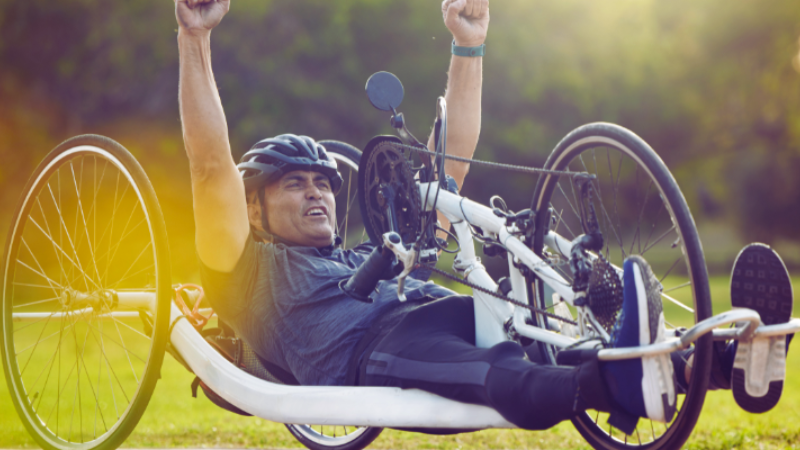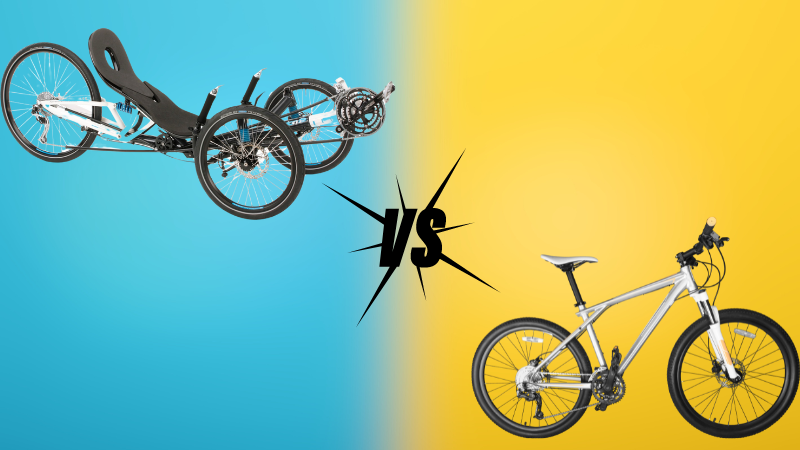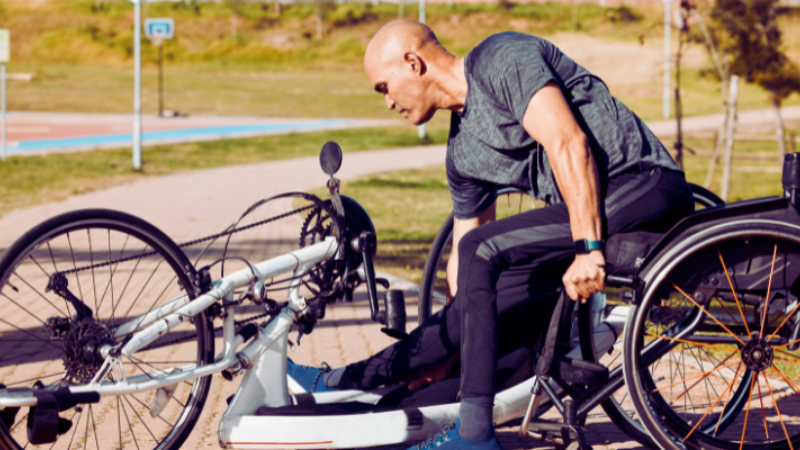Curious about what a recumbent bicycle is? These uniquely designed bikes offer a whole new perspective on cycling, providing riders with a laid-back and comfortable riding experience. In this guide, we’ll explore recumbent bicycles, their design, benefits, and some of the best options available on the market today.
What is a Recumbent Bike?

Recumbent bike, often referred to as “recumbents,” feature a distinctive design where the rider sits in a reclined position. Unlike traditional bicycles where riders sit upright, recumbents allow cyclists to pedal while leaning back, supported by a comfortable seat. Also, you can learn about the types of bicycles.
Comfort and Ergonomics
One of the most significant advantages of recumbent bicycles is their ergonomic design. By reclining the rider’s position, recumbents reduce strain on the back, neck, and shoulders, offering a more relaxed and comfortable riding experience. This makes recumbents particularly appealing to individuals with back issues or those seeking a more leisurely ride.
Improved Stability and Handling
Recumbent bicycles boast a lower center of gravity compared to traditional bikes, improving stability and handling, especially at higher speeds or on uneven terrain. The balanced weight distribution contributes to a smoother and more controlled ride, allowing cyclists to navigate various riding conditions with ease.
Aerodynamic Efficiency
Another notable feature of recumbent bicycles is their aerodynamic profile. With riders positioned closer to the ground, recumbents minimize wind resistance, resulting in faster speeds and improved efficiency. This aerodynamic advantage makes recumbents a popular choice for cyclists looking to maximize their performance on the road or track.
Electric Recumbent Bicycle
In recent years, electric-assist recumbent bicycles have gained popularity, offering an extra boost of power when pedaling. These electric motors provide assistance, particularly helpful when tackling steep inclines or covering long distances. Electric recumbents provide riders with a seamless and enjoyable riding experience, combining the benefits of traditional cycling with the convenience of electric propulsion.
Top Recumbent Bicycles
When it comes to choosing the best recumbent bicycle, several reputable brands offer a range of models to suit different preferences and riding styles. Let’s explore some of the top options available:
- Schwinn: Known for its reliability and comfort, Schwinn offers a diverse lineup of recumbent bicycles, featuring adjustable seats, multiple speed options, and sturdy construction.
- Catrike: Specializing in high-performance recumbent trikes, Catrike delivers lightweight and agile bikes designed for speed and maneuverability.
- TerraTrike: With a focus on versatility and adventure, TerraTrike produces recumbent trikes suitable for riders of all skill levels. Their models are built to handle various terrains, making them perfect for leisurely rides or off-road exploration.
Bicycle Laying Down vs. Traditional Upright Bikes
When it comes to choosing a bicycle, there are two primary options: bicycle laying down and traditional upright bikes.

Each type has its unique features, advantages, and disadvantages. Let’s conduct a comparative analysis to help you understand which might be the better fit for your needs.
Recumbent Bicycles
Unique Features:
- Recumbent bicycles feature a reclined seating position, with the rider’s legs extended in front.
- They typically have a larger, more comfortable seat with back support.
- Recumbent bikes often come in various styles, including two-wheelers, trikes, and handcycles.
Recumbent Bike Benefits:
- Comfort: The reclined position reduces strain on the back, neck, and wrists, making long rides more comfortable.
- Aerodynamics: The lower seating position offers better aerodynamics, potentially leading to higher speeds with less effort.
- Stability: Recumbent bicycles have a lower center of gravity, providing improved stability, especially at higher speeds or on uneven terrain.
Disadvantages:
- Visibility: The lower seating position can reduce visibility in traffic, potentially increasing the risk of accidents.
- Learning Curve: Riding a recumbent bike may require some adjustment for beginners accustomed to traditional bikes.
- Storage and Transport: Recumbent bicycles can be bulkier and more challenging to store or transport compared to upright bikes.
Traditional Upright Bikes
Unique Features:
- Traditional upright bikes feature a vertical seating position, with the rider sitting on a narrow saddle.
- They have a simple, lightweight frame design, with handlebars positioned above the seat.
Advantages:
- Visibility: The upright position provides better visibility in traffic, making it easier for riders to be seen by other road users.
- Maneuverability: Upright bikes are often more agile and easier to handle, particularly in tight spaces or crowded urban environments.
- Familiarity: Most people are familiar with riding upright bikes, making them a natural choice for beginners.
Disadvantages:
- Comfort: The upright position can lead to discomfort, particularly on longer rides, as it puts more strain on the back, neck, and wrists.
- Aerodynamics: Upright bikes have higher wind resistance, requiring more effort to maintain speed, especially in windy conditions.
- Stability: Upright bikes have a higher center of gravity, making them less stable, particularly at higher speeds or on rough terrain.
Lay Down Cycle for Individuals with Mobility Limitations or Disabilities
Traditional upright bikes can be challenging for people with mobility issues or disabilities. Recumbent bicycles offer a more comfortable alternative. They have a reclined seat with back support, easing strain on the body. This makes them suitable for people with conditions like arthritis or back pain.
Recumbent bikes are stable, making them great for those with balance problems. They come in different styles, like trikes or handcycles, catering to various needs. Plus, they can be customized for comfort with adjustable features.
Recumbent biking also fosters a sense of community through group rides and events. This inclusivity makes cycling accessible and enjoyable for everyone. Overall, recumbent bicycles provide a comfortable and welcoming way for people with mobility limitations or disabilities to enjoy cycling.
Customization Options for Recumbent Bikes

Recumbent bikes offer riders a plethora of customization options, ensuring that each bike can be tailored to fit individual needs and preferences. Let’s explore some key customization features available for recumbent bicycles:
Adjustable Seats: One significant aspect of customization is the ability to adjust the seat. Riders can tweak the seat angle, height, and position to find the most comfortable riding posture. This flexibility is crucial for accommodating different body sizes and shapes, as well as addressing specific comfort requirements, such as back issues.
Frame Sizes: Recumbent bicycles come in various frame sizes, catering to riders of different heights and builds. By offering a range of frame sizes, manufacturers ensure that riders can find the right fit for optimal comfort and performance. Choosing the correct frame size also contributes to efficient power transfer and handling.
Gearing Systems: Customizing the gearing system allows riders to tailor their bike’s performance to their riding style and terrain. With a variety of gear ratios available, cyclists can select the setup that best suits their needs, whether it’s for flat city streets or hilly countryside roads. Different gearing options, such as internal hub gears or external derailleur systems, offer versatility and adaptability.
Handlebar Configurations: Recumbent bicycles offer various handlebar configurations to accommodate different preferences. Options like under-seat steering (USS) or above-seat steering (ASS) provide riders with choices for a relaxed or more upright riding position. Riders can also select handlebar shapes, widths, and grips to customize their setup for comfort and control.
Accessory Mounting Options: Many recumbent bicycles come equipped with mounting points for accessories like racks, fenders, and lights. These mounting options enable riders to customize their bikes for commuting, touring, or recreational riding by adding essential gear. Additionally, aftermarket accessories such as mirrors or GPS units can be easily installed to improve functionality.
Conclusion of Recumbent Bicycle
In conclusion, recumbent bicycles offer a comfortable and accessible alternative to traditional upright bikes, making cycling enjoyable for individuals with mobility limitations or disabilities.
With features like adjustable seats, customizable frame sizes, gearing systems, handlebar configurations, and accessory mounting options, recumbent bikes can be tailored to suit the specific needs and preferences of riders.